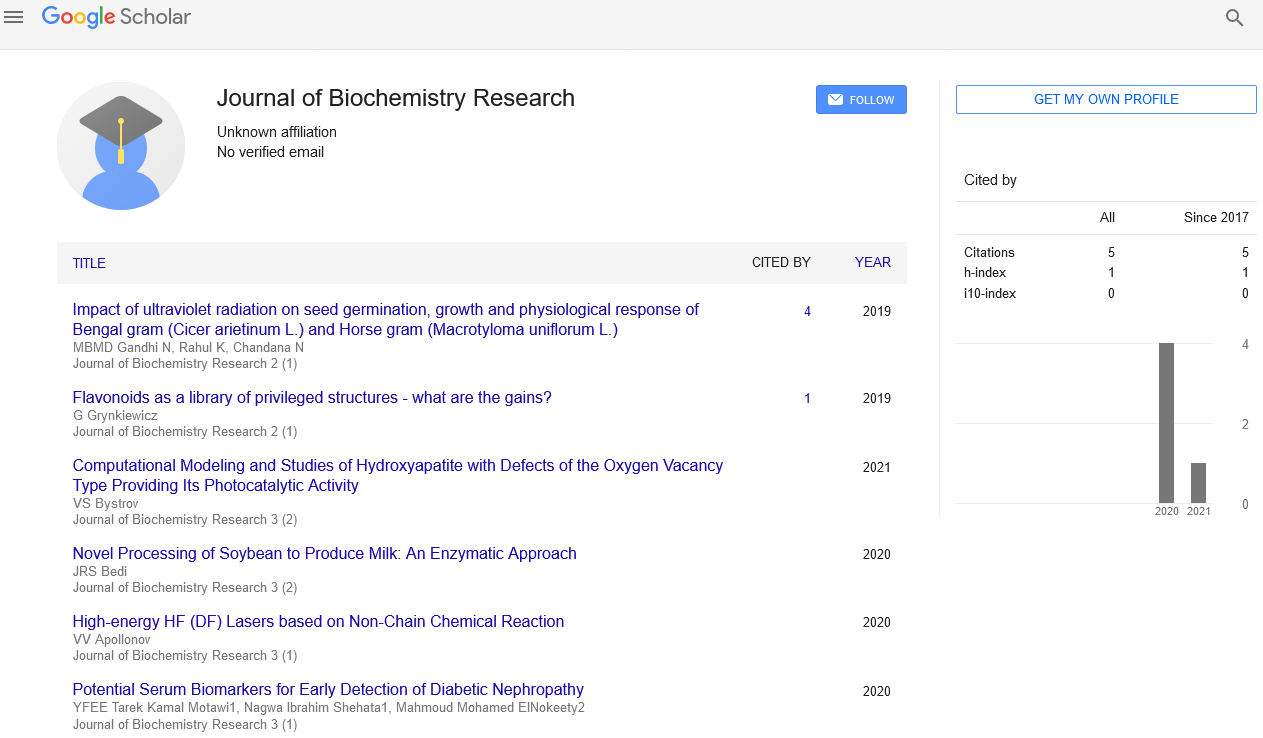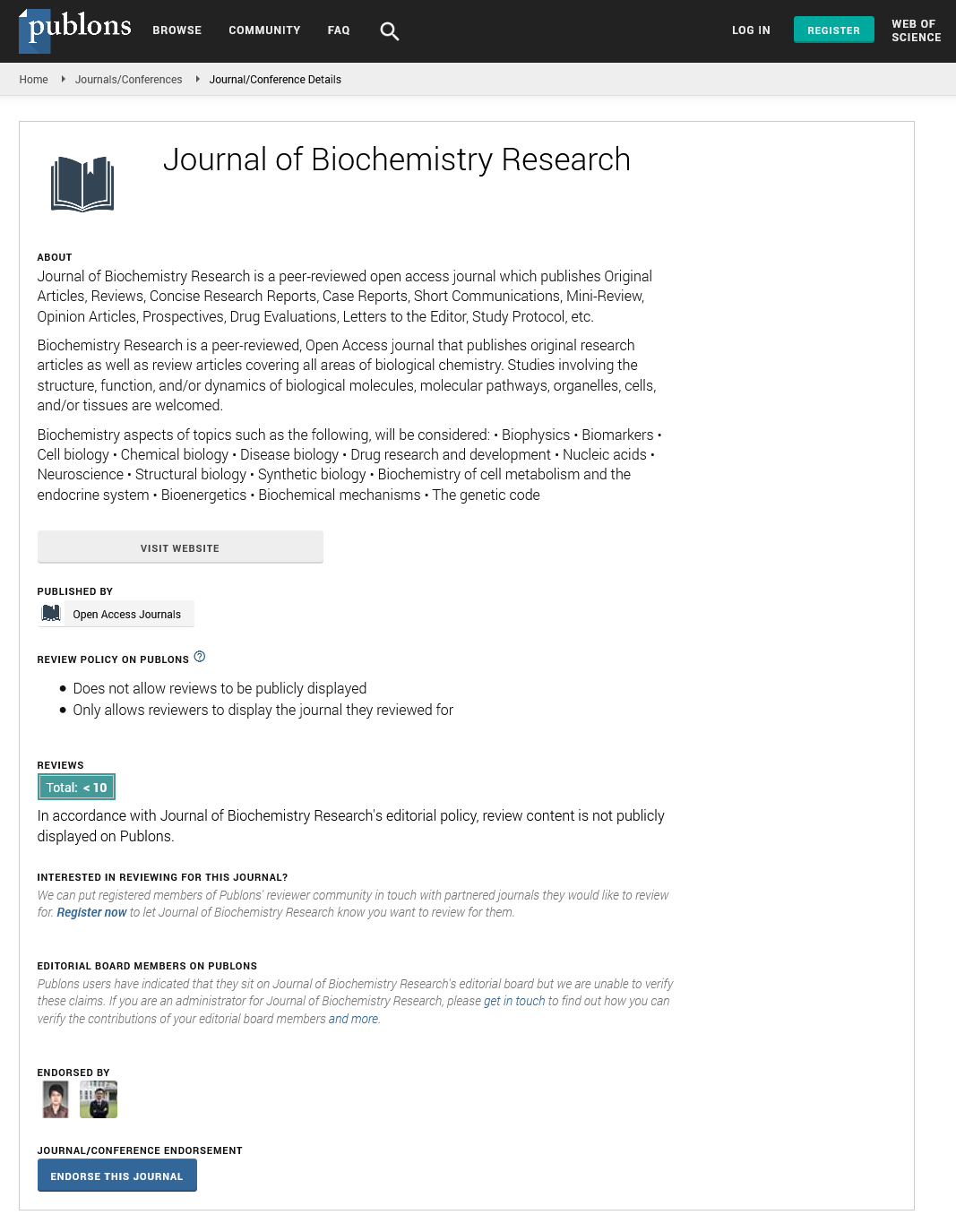Editorial - Journal of Biochemistry Research (2023) Volume 6, Issue 3
Decoding the Complex Interplay: The Intricate Relationship between Cancer and Immune Function
Hasen Ren*
Department of biochemistry, Research Laboratory and University of Canada
- *Corresponding Author:
- Hasen Ren
Department of biochemistry, Research Laboratory and University of Canada
E-mail: hasenr@gmail.com
Abstract
The intricate relationship between cancer and immune function is a captivating area of research that holds significant implications for understanding disease progression and developing novel therapeutic approaches. The immune system plays a crucial role in recognizing and eliminating cancer cells, but cancer has evolved sophisticated mechanisms to evade immune surveillance and create an immunosuppressive environment. This article delves into the multifaceted interplay between cancer and immune function, shedding light on the strategies employed by cancer cells to manipulate the immune system and the emerging therapeutic avenues that harness the power of the immune response to combat cancer.
Keywords
Cancer • Immune function • Immune surveillance • Tumor evasion • Immune checkpoint inhibitors • CAR-T cell therapy • Cancer vaccines • Immunomodulators • Gut microbiome • Therapeutic interventions
Introduction
Cancer and immune function are intricately linked, engaging in a complex interplay that can have profound implications for both disease progression and treatment outcomes. The immune system plays a vital role in recognizing and eliminating abnormal cells, including cancerous ones. However, cancer can evade immune surveillance and create an immunosuppressive environment, allowing it to thrive and evade destruction [1]. In this article, we will explore the relationship between cancer and immune function, highlighting the ways cancer cells manipulate the immune system and the emerging strategies to harness the immune response for cancer treatment. The relationship between cancer and immune function is a complex and fascinating area of study that has garnered significant attention in recent years [2]. The immune system, a highly intricate network of cells, tissues, and molecules, plays a critical role in recognizing and eliminating abnormal cells, including cancerous ones. However, cancer has the ability to subvert and manipulate the immune system, allowing it to evade detection and destruction, leading to disease progression [3]. Immune surveillance is a vital process through which the immune system identifies and eliminates potentially harmful cells, including cancer cells [4]. Various immune cells, such as T cells, B cells, natural killer cells, and macrophages, work in concert to recognize and eradicate these aberrant cells [5]. The immune response is initiated when these cells recognize specific antigens displayed on the surface of cancer cells or detect molecular changes associated with the transformation [6]. Cancer, on the other hand, has developed sophisticated strategies to evade immune surveillance and establish itself within the body. One such strategy involves downregulating the expression of antigens on the surface of cancer cells, making them less visible to the immune system. Additionally, cancer cells can produce inhibitory molecules, such as programmed death-ligand 1 (PD-L1), which interact with immune checkpoints, effectively deactivating T cells and dampening the immune response [7]. Moreover, tumors can create an immunosuppressive microenvironment by recruiting regulatory T cells and myeloidderived suppressor cells, which suppress the activity of immune cells and facilitate tumor growth. Advances in understanding the intricate relationship between cancer and immune function have led to the development of revolutionary immunotherapies [8]. Immune checkpoint inhibitors, such as antibodies targeting programmed cell death protein 1 (PD-1), PD-L1, and cytotoxic T-lymphocyte-associated protein 4 (CTLA-4), have shown remarkable success in unleashing the immune system to attack cancer cells.
By blocking the inhibitory signals, these therapies restore the immune response and have demonstrated durable responses in various cancer types. Another promising approach is chimeric antigen receptor T-cell therapy (CAR-T), which involves genetically modifying a patient’s T cells to express a receptor that recognizes specific cancer-associated antigens [9]. These modified CAR-T cells are then infused back into the patient, where they can target and destroy cancer cells. CAR-T therapy has shown impressive results in certain blood cancers and offers a personalized treatment option. In addition to checkpoint inhibitors and CAR-T therapy, researchers are exploring the potential of cancer vaccines and immunomodulatory agents to boost immune responses against cancer [10]. Cancer vaccines aim to train the immune system to recognize and target cancer cells by presenting tumor antigens. Immunomodulators, on the other hand, stimulate the immune system or overcome immune suppression within the tumor microenvironment, enhancing the efficacy of cancer treatments.
Materials and Methods
Immune system and cancer: The role of the immune system in cancer surveillance and recognition of abnormal cells was explored. Key components of the immune system, including T cells, B cells, natural killer cells, and macrophages, were studied to understand their functions in immune surveillance and response against cancer cells.
Tumor evasion mechanisms: The strategies employed by cancer cells to evade immune surveillance were investigated. This involved examining the downregulation of surface antigens on cancer cells, the production of inhibitory molecules (such as PD-L1), and the recruitment of immunosuppressive cells within the tumor microenvironment. Cancer cells employ several strategies to evade the immune system, enabling them to establish and grow tumors. One mechanism involves downregulating the expression of antigens on the cell surface, making it difficult for immune cells to recognize them. Cancer cells can also produce inhibitory molecules, such as PDL1, that interact with immune checkpoints, effectively deactivating T cells and preventing an immune response. Additionally, tumors can create an immunosuppressive microenvironment by recruiting regulatory T cells and myeloidderived suppressor cells, which inhibit immune cell activity.
Immune checkpoint inhibitors: The mechanism and clinical applications of immune checkpoint inhibitors, such as antibodies targeting PD-1, PD-L1, and CTLA-4, were explored. The effectiveness of these inhibitors in restoring the immune response against cancer cells and their implications in various cancer types were reviewed. Immunotherapies, particularly immune checkpoint inhibitors, have revolutionized cancer treatment by targeting the mechanisms employed by cancer cells to evade immune surveillance. By releasing the brakes on the immune system, these therapies unleash a robust immune response against the tumor, leading to durable responses in some patients across a range of cancer types.
CAR-T cell therapy: The principles and techniques involved in chimeric antigen receptor (CAR) T-cell therapy were investigated. This included understanding the process of modifying patient T cells to express CARs specific to cancerassociated antigens, the infusion of CAR-T cells into patients, and the clinical outcomes of CAR-T therapy in different malignancies. Another promising approach is chimeric antigen receptor T-cell therapy (CAR-T), which involves modifying a patient’s T cells to express a receptor that specifically recognizes cancer cells. CAR-T cells are engineered to target tumor-associated antigens and are infused back into the patient, where they can recognize and kill cancer cells. This personalized therapy has shown remarkable success in treating certain blood cancers, such as acute lymphoblastic leukemia and diffuse large B-cell lymphoma.
The immune system’s role in cancer surveillance: The immune system acts as a defense mechanism, protecting the body from infections, foreign substances, and abnormal cells. Cells of the immune system, such as T cells, B cells, natural killer cells, and macrophages, work together to recognize and eliminate cancer cells. This process is known as immune surveillance. Immune cells can identify and destroy cancer cells by recognizing specific antigens displayed on their surface or by recognizing molecular changes associated with transformation.
Conclusion
The intricate relationship between cancer and immune function is a captivating field of study that has revolutionized cancer research and treatment. The immune system plays a vital role in recognizing and eliminating cancer cells, while cancer cells have evolved strategies to evade immune surveillance and create an immunosuppressive environment, enabling disease progression. The development of immunotherapies has transformed cancer treatment by targeting the mechanisms through which cancer cells manipulate the immune system. Immune checkpoint inhibitors, such as antibodies against PD-1, PD-L1, and CTLA-4, have shown remarkable success in unleashing the immune response against cancer cells, leading to durable responses in various cancer types. CAR-T cell therapy has emerged as a personalized approach, genetically modifying a patient’s T cells to target cancer-associated antigens, resulting in significant clinical outcomes in certain blood cancers.
References
- Makam AN, Nguyen OK. An Evidence-Based Medicine Approach to Antihyperglycemic Therapy in Diabetes Mellitus to Overcome Overtreatment. Circulation. 135, 180-195 (2017).
- Meng Y, Bai H, Wang S et al. Efficacy of low carbohydrate diet for type 2 diabetes mellitus management: A systematic review and meta-analysis of randomized controlled trials. J Diabetes Res. 131, 124-131 (2017).
- Lvovs D, Favorova OO, Favorov AV et al. A Polygenic Approach to the Study of Polygenic Diseases. Acta Naturae. 4, 59-71 (2012).
- Kobayashi H. Airway biofilms: implications for pathogenesis and therapy of respiratory tract infections. Respiratory medicine. 4, 241-253 (2005).
- Harrison, Paul. How shall I say it? Relating the nonrelational .EnvironPlan A. 39, 590-608 (2007).
- Van Norman GA. Phase II Trials in Drug Development and Adaptive Trial Design. JACCTransl Sci. 4, 428-437 (2019).
- Orgel LE.The origin of life--a review of facts and speculations. Trends Biochem. Sci. 23, 491-495 (1998).
- Acharya UR, Faust O, Sree V et al. Linear and nonlinear analysis of normal and CAD-affected heart rate signals. Comput Methods Programs Bio. 113, 55–68 (2014).
- Dwyer, Claire. ‘Highway to Heaven’: the creation of a multicultural, religious landscape in suburban Richmond, British Columbia. Soc Cult Geogr. 17, 667-693 (2016).
- Bianconi, Piovesan, Allisonet et al. An estimation of the number of cells in the human body. Ann HumBiol.40, 463-471 (2013).
Indexed at, Google Scholar, Crossref
Indexed at, Google Scholar, Crossref
Indexed at, Google Scholar Crossref
Indexed at, Google Scholar, Crossref
Indexed at, Google Scholar, Crossref
Indexed at, Google Scholar, Crossref
Indexed at, Google Scholar, Crossref
Indexed at, Google Scholar, Crossref
Indexed at, Google Scholar, Crossref


